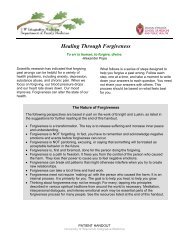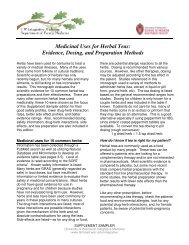Mental Notes Magazine - UW Family Medicine - University of ...
Mental Notes Magazine - UW Family Medicine - University of ...
Mental Notes Magazine - UW Family Medicine - University of ...
Create successful ePaper yourself
Turn your PDF publications into a flip-book with our unique Google optimized e-Paper software.
Mirror matching provides a simple hypothesis for<br />
explaining aspects <strong>of</strong> social empathy<br />
These observations are countered by other studies,<br />
however, showing an important role for innate factors in<br />
empathy and mirror system development. For example,<br />
patients with a congenital insensitivity to pain (CIP),<br />
have a pr<strong>of</strong>ound decrease in lifetime pain sensation,<br />
allowing the study <strong>of</strong> how a lack <strong>of</strong> prior pain experience<br />
affects mirror system development for pain. Surprisingly,<br />
patients with CIP demonstrate a normal brain activity<br />
response to observing pain in others, revealing that a<br />
substantial portion <strong>of</strong> mirror system development for<br />
pain may, in fact, be innate 8 . Other studies <strong>of</strong> patients<br />
with CIP show that they also demonstrate a normal<br />
ability to infer pain from facial expression 9 . Collectively,<br />
these studies suggest that innate as well as experiential<br />
factors are important in the normal development <strong>of</strong><br />
mirror systems and empathic abilities.<br />
While innate versus experience-dependent<br />
contributions to mirror system development constitute<br />
one area <strong>of</strong> research, other studies endeavor to<br />
understand where, within the mirror systems, specificity<br />
for emotional recognition is subserved. Though mirror<br />
matching provides a simple and attractive hypothesis<br />
for explaining aspects <strong>of</strong> social empathy, widely differing<br />
emotions have been shown to activate similar brain<br />
regions. The amygdala, for instance, has been shown<br />
to exhibit similar activation to movies <strong>of</strong> happy, fearful,<br />
disgusted, and neutral facial expressions 10 . This calls<br />
into question how the brain appropriately recognizes<br />
and differentiates among the gamut <strong>of</strong> emotions other<br />
humans can exhibit and communicate. This lack <strong>of</strong><br />
specificity in neural activation in response to others’<br />
emotional expressions calls for an added level <strong>of</strong><br />
resolution, perhaps at the level <strong>of</strong> individual neurons<br />
embedded within these regions or at the level <strong>of</strong><br />
interacting neuroanatomical areas 11 .<br />
Combined, these observations raise a spectrum <strong>of</strong><br />
interesting questions that might further advance our<br />
understanding <strong>of</strong> empathy. Examples include: What<br />
genetic factors regulate the innate substructure <strong>of</strong> mirror<br />
systems and empathy How does prior experience<br />
interact with these innate factors Is it possible to<br />
provide a more detailed map <strong>of</strong> basic neurobiology<br />
subserving empathy, at the level <strong>of</strong> interacting<br />
neuroanatomical regions and possibly individual<br />
neurons Uncovering answers to these questions will<br />
require not only continued human research but also<br />
novel animal models for studying the neural circuitry<br />
<strong>of</strong> empathy. Such models may allow us to investigate<br />
genetic factors contributing to empathy as well as its<br />
plasticity in response to prior learning. These animal<br />
models may also help elaborate further novel circuitries<br />
that are difficult to pursue in human research. Toward<br />
this goal, several rodent protocols have been developed<br />
to model human empathy. Although it is debatable<br />
whether these behaviors are true evidence <strong>of</strong> the<br />
human equivalent <strong>of</strong> empathy within rodents, they<br />
have been interpreted as representing an “emotional<br />
contagion”, or primitive form <strong>of</strong> empathic responding.<br />
Emotional contagion can still occur among humans but<br />
entails a less sophisticated form <strong>of</strong> social connection,<br />
which seems to operate at a more implicit, unconscious<br />
level than the more intentional, cognitive processes<br />
involved in human empathy. For example, in an effort to<br />
model innate contributions to empathy-like behaviors,<br />
researchers have shown that the genetic background<br />
<strong>of</strong> rodents can modulate their empathy-like responses.<br />
Previous exposure to the fear <strong>of</strong> other mice facilitates<br />
the ability <strong>of</strong> C57BL/6J (B6) mice, a gregarious strain,<br />
to learn fearful associations, suggesting that mice<br />
receive information about the fear <strong>of</strong> other species<br />
What genetic factors regulate empathy<br />
Summer 2012 / <strong>Mental</strong> <strong>Notes</strong> / 21

















